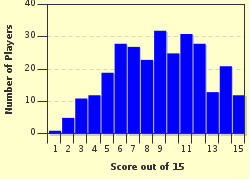Quiz Answer Key and Fun Facts
1. The blues, as a musical entity, began to take shape in the earliest years of the 20th Century. The earliest purveyors of the music were farm hands on the southern plantations and semi-professional musicians who performed at house parties, juke joints and as buskers on street corners throughout the south. They were predominantly black males. When it came to recording the music early in the 1920s however, females led the way starting with Mamie Smith's classic "Crazy Blues" in 1920. But it was another woman, a protégé of Ma Rainey, who truly became the foremost blues vocalist of the era earning the sobriquet "Empress of the Blues". Among her memorable hits were "Down Hearted Blues", "The St. Louis Blues" and "Backwater Blues". Who was she?
2. Robert Johnson is, without question, the most celebrated figure in the history of the blues. The voice, the lyrics and the guitar playing are legendary. He died in 1938 at the age of 27, leaving behind his legacy of 29 recorded songs, 41 if alternate tracks are included. Do you know how he met his maker?
3. The beauty of the blues is that the songs were not the creation of someone hunched over music sheets in Tin Pan Alley. They were almost always conceived by the artist who performed them. It was their song and theirs alone and rarely would colleagues and peers cover another person's work. Well, at least until the rock bands started doing it in the 1960s and ever since. Hence, it's generally pretty easy to identify classic songs with the performer... if you know the blues! We'll start with the famous Chicago bluesman Muddy Waters. Which of the following classics was NOT one of his compositions?
4. Jimmy Reed was another famous bluesman of the Chicago school. Many of his bigger hits on the black charts found broader appeal to the general public as well and made appearances on the Hot 100 charts. His impact on rock & roll was such that he was inducted into that Hall of Fame in 1991. Which of the following songs was NOT a Jimmy Reed recording?
5. Many blues artists, who may have been great, somehow fell through the cracks and never had the opportunity to record their offerings. Others recorded a few sides and were never heard of again. Such might have been the case for the subject of this question. In 1928, he was lucky enough to record seven tracks for OKeh Records, none of which were big sellers at the time. He returned home to Mississippi, worked as a sharecropper and day laborer and performed on weekends at local parties in total anonymity. He never had the chance to record again, OKeh Records having folded with the onset of the depression. Then fate stepped in. Rediscovered in 1963, he would become a blues superstar at the age of 70. Among his most famous pieces were "Candy Man Blues" and "Avalon Blues". Who was this man?
6. Not all blue styles are devoted to "feeling blue". Quite to the contrary, "jump blues" is playful to the point of being downright raucous. Listen to these songs from the 1940s to get the point; "Saturday Night Fish Fry", "Caldonia" and "Choo-Choo Ch-Boogie". What jump blues artist made those songs major hits on the contemporary charts of the day?
7. The state of Louisiana has long been among the geographical areas in the forefront of "roots" music in the U.S. New Orleans was the cradle of jazz, Dixieland style, but the blues didn't figure as prominently there as it did elsewhere in the state, particularly in the region around Baton Rouge where artists like Slim Harpo, Lightin' Slim and Lazy Lester held forth singing "swamp blues". Of course, New Orleans had blues practitioners but they were more of the "rhythm and blues" style as exemplified by Professor Longhair and Fats Domino. Three of the songs listed below were notable as Slim Harpo compositions. The other was a Professor Longhair standard. Which one is it?
8. Louisiana was also the home for a true "roots" blues legend, Huddie Leadbetter, better known as "Leadbelly". Although he had been singing and playing his adaptations of traditional folk songs since before the turn of the 20th Century, he really wasn't "discovered" until the early 1930s. His repertoire of songs was enormous, probably unequaled by any one else of the era and many of them became identified as Leadbelly songs. Which of the following was NOT?
9. Before we move on to other pastures, the state of Louisiana has given us another blues style worthy of mention - Zydeco. Among the four choices below, three are acknowledged as Zydeco artists, one is not. Which artist is the odd one out?
10. Born in 1925, this bluesman was considered the reigning "King of the Blues" during the last half of the 20th Century. Who was it that scored with such hits as "The Thrill Is Gone", "Rock Me Baby", and "Paying The Cost To Be Boss"?
11. Although most bluesmen composed their own songs and would sing them exclusively, there was the odd exception to the rule. Willie Dixon was a capable bass man and backed up many of Chicago's blues greats live and on recording sessions beginning in the late 1940s. But he made his mark with Chess Records for close to twenty years as a composer and arranger for other artists in the Chess stable. One of his great collaborators was Howlin' Wolf and from 1960 to 1965 they did some of their finest work together. Which of the following songs was NOT a collaboration of theirs?
12. Born in Clarksdale, Mississippi in 1917, the subject of this question did not follow the crowd to Memphis or Chicago like so many of his peers. Instead, he migrated to Detroit in 1943 and became a staple of that city's blues scene for decades to come. His discography of albums was enormous but oddly enough, only nine released singles were popular enough to make appearances on Billboard's R&B chart, all between 1949 and 1962. But they were classics, nevertheless. Included among them were "Boogie Chillen'", "I'm In The Mood", (both Number Ones), "Boom Boom" and "Crawlin' King Snake". One final clue - he made an all too brief cameo appearance in the movie "The Blues Brothers". Who was this man?
13. Much has been made of the influence that the blues has had on the development of rock and roll over the years. Many rock and roll bands such as the Rolling Stones, Fleetwood Mac, Cream and Led Zeppelin had their roots in the blues and evolved into what only could be called blues-rock bands. Which of the following "rock" bands does not fit this definition?
14. After the guitar, the instrument most closely identified with the blues would be the harmonica, mouth harp or mouth organ, whichever you prefer. Which of the following artists was primarily known for his expertise as a "harpist"?
15. You've taken the quiz and now you have a hankering to see a contemporary blues artist in action... and you should! There are venues to hear the blues in virtually every major city in North America and there are blues festivals scattered all over the continent and in Europe as well. Which of the following names is NOT deemed to be a contemporary blues artist?
Source: Author
maddogrick16
This quiz was reviewed by FunTrivia editor
ralzzz before going online.
Any errors found in FunTrivia content are routinely corrected through our feedback system.

